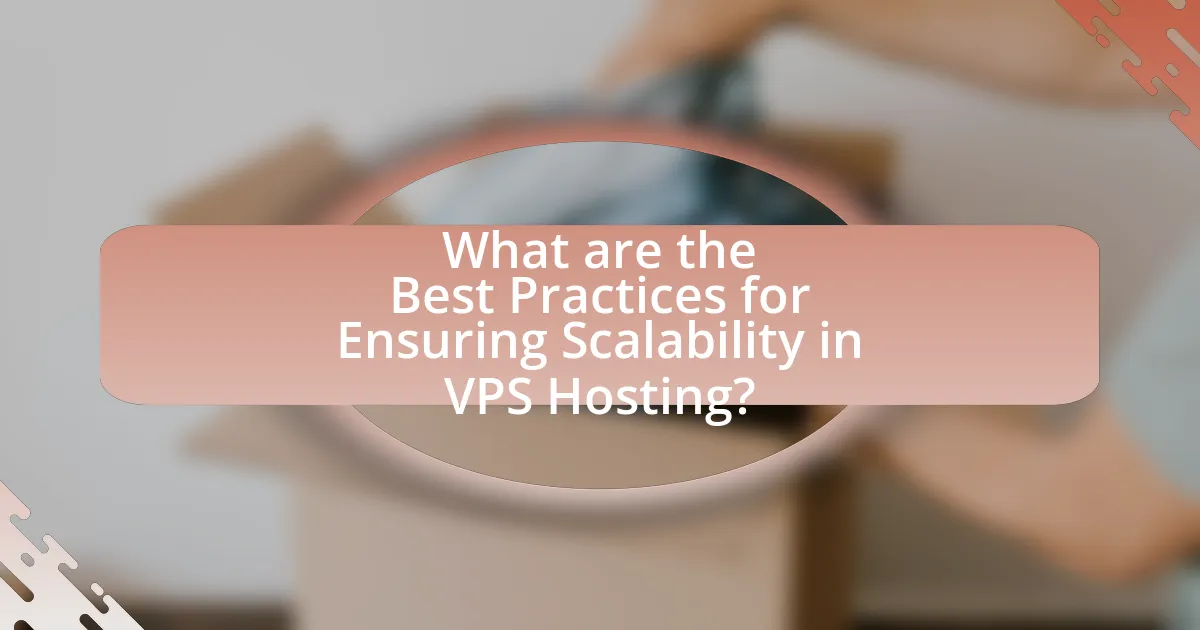VPS hosting, or Virtual Private Server hosting, is a web hosting solution that utilizes virtualization technology to provide dedicated resources on a physical server, offering users greater control and flexibility compared to shared hosting. Scalability is a critical aspect of VPS hosting, allowing businesses to adjust their resources in response to fluctuating demands, which is essential for maintaining performance and cost-efficiency. The article explores the differences between VPS hosting and other hosting solutions, key features, common scalability challenges, and effective strategies for enhancing scalability. Additionally, it discusses the role of server management, virtualization technologies, and best practices for optimizing resource allocation to ensure efficient scaling in VPS environments.

What is VPS Hosting and Why is Scalability Important?
VPS hosting, or Virtual Private Server hosting, is a type of web hosting that uses virtualization technology to provide dedicated resources on a physical server. This allows users to have more control and flexibility compared to shared hosting, as each VPS operates independently with its own operating system and allocated resources. Scalability is important in VPS hosting because it enables businesses to adjust their resources according to changing demands, ensuring optimal performance and cost-efficiency. For instance, a study by HostingAdvice found that 70% of businesses experience fluctuating traffic, making the ability to scale resources up or down crucial for maintaining service quality and managing costs effectively.
How does VPS Hosting differ from other hosting solutions?
VPS hosting differs from other hosting solutions primarily in its allocation of dedicated resources and enhanced control. Unlike shared hosting, where multiple users share the same server resources, VPS (Virtual Private Server) hosting provides each user with a portion of the server’s resources, ensuring better performance and stability. Additionally, VPS hosting offers root access, allowing users to install custom software and configure their environments, which is not typically available in shared hosting. In contrast to dedicated hosting, VPS is more cost-effective while still providing a level of isolation and customization that shared hosting cannot offer. This combination of dedicated resources and flexibility makes VPS hosting a scalable solution suitable for growing businesses that require more than what shared hosting can provide but do not yet need a full dedicated server.
What are the key features of VPS Hosting?
VPS hosting offers several key features that enhance its performance and usability. Firstly, it provides dedicated resources, including CPU, RAM, and storage, which ensures consistent performance and reliability. Additionally, VPS hosting allows for root access, enabling users to install and configure software as needed, thus offering greater control over the server environment. Scalability is another significant feature, as users can easily upgrade their resources based on demand without experiencing downtime. Furthermore, VPS hosting typically includes enhanced security measures, such as firewalls and isolated environments, which protect against potential threats. These features collectively make VPS hosting a flexible and powerful solution for various hosting needs.
Why is scalability a critical factor in VPS Hosting?
Scalability is a critical factor in VPS hosting because it allows businesses to adjust their resources based on fluctuating demands. This flexibility ensures that as traffic increases or decreases, the hosting environment can be modified without significant downtime or performance issues. For instance, a study by Hostinger indicates that 70% of businesses experience varying traffic patterns, making scalability essential for maintaining optimal performance and cost-efficiency. By enabling users to easily upgrade or downgrade their resources, VPS hosting supports growth and operational efficiency, which is vital for competitive advantage in the digital landscape.
What are the common scalability challenges faced in VPS Hosting?
Common scalability challenges faced in VPS hosting include limited resources, performance bottlenecks, and management complexity. Limited resources arise because each VPS is allocated a fixed amount of CPU, RAM, and storage, which can restrict growth as traffic increases. Performance bottlenecks occur when the underlying physical server becomes overloaded, affecting all VPS instances on that server. Management complexity increases as users scale their applications, requiring more sophisticated configurations and monitoring to ensure optimal performance. These challenges can hinder the ability to effectively scale VPS hosting solutions in response to growing demands.
How do resource limitations impact scalability?
Resource limitations significantly hinder scalability by restricting the ability to increase capacity and performance in response to growing demands. When a system, such as a Virtual Private Server (VPS), lacks sufficient CPU, memory, or storage resources, it cannot efficiently handle additional workloads or user requests. For instance, a VPS with limited RAM may experience slow response times or crashes when traffic spikes, directly impacting user experience and service reliability. This correlation between resource constraints and scalability is supported by industry observations, where organizations often face performance bottlenecks due to inadequate resources, leading to potential revenue loss and customer dissatisfaction.
What role does server management play in scalability issues?
Server management is crucial in addressing scalability issues as it ensures optimal resource allocation and performance tuning. Effective server management allows for the monitoring of server loads, enabling administrators to identify bottlenecks and adjust resources accordingly. For instance, a study by Gartner indicates that organizations with proactive server management can improve their scalability by up to 30%, as they can dynamically allocate resources based on real-time demand. This adaptability is essential for maintaining performance during traffic spikes, thereby directly impacting the scalability of VPS hosting solutions.

How Can VPS Hosting Solutions Scale Effectively?
VPS hosting solutions can scale effectively by allowing users to adjust resources such as CPU, RAM, and storage based on demand. This flexibility enables businesses to accommodate traffic spikes without significant downtime or performance degradation. For instance, many VPS providers offer a pay-as-you-go model, which allows users to only pay for the resources they utilize, making it cost-effective. Additionally, VPS environments can be easily replicated or migrated to more powerful servers as needed, ensuring that performance remains optimal as business needs grow. This adaptability is supported by virtualization technology, which isolates resources and allows for seamless scaling.
What strategies can be employed to enhance scalability in VPS Hosting?
To enhance scalability in VPS hosting, implementing resource allocation strategies is essential. This includes utilizing dynamic resource scaling, which allows for automatic adjustments of CPU, RAM, and storage based on current demand. For instance, cloud VPS providers often offer features that enable users to scale resources up or down seamlessly, ensuring optimal performance during peak usage times. Additionally, employing load balancing techniques distributes traffic across multiple servers, preventing any single server from becoming a bottleneck. According to a study by Gartner, organizations that adopt scalable cloud solutions can improve their operational efficiency by up to 30%, demonstrating the effectiveness of these strategies in enhancing scalability.
How does vertical scaling work in VPS environments?
Vertical scaling in VPS environments involves increasing the resources of a single virtual private server to enhance its performance. This process typically includes upgrading CPU, RAM, or storage capacity without the need to migrate to a different server. For instance, a VPS provider may allow users to adjust their resource allocation through a control panel, enabling seamless scaling as demand fluctuates. This method is efficient for applications that require more power but do not need to distribute workloads across multiple servers.
What are the benefits of horizontal scaling in VPS Hosting?
Horizontal scaling in VPS hosting allows for the addition of more virtual servers to handle increased load, enhancing performance and reliability. This approach improves resource allocation by distributing workloads across multiple servers, which minimizes the risk of downtime and bottlenecks. Additionally, horizontal scaling offers cost-effectiveness, as users can scale resources based on demand without the need for significant upfront investment in hardware. According to a study by Gartner, organizations that implement horizontal scaling can achieve up to 50% better resource utilization compared to vertical scaling methods.
What technologies support scalable VPS Hosting solutions?
Virtual Private Server (VPS) hosting solutions are supported by several key technologies that enhance scalability. These technologies include virtualization software, such as KVM (Kernel-based Virtual Machine) and VMware, which allow multiple virtual servers to run on a single physical server, optimizing resource allocation. Additionally, containerization technologies like Docker enable efficient deployment and management of applications, facilitating rapid scaling. Cloud infrastructure, exemplified by services from AWS and Google Cloud, provides on-demand resources that can be adjusted based on traffic and usage patterns. Furthermore, orchestration tools like Kubernetes automate the management of containerized applications, ensuring they can scale seamlessly. These technologies collectively ensure that VPS hosting can adapt to varying demands while maintaining performance and reliability.
How do virtualization technologies contribute to scalability?
Virtualization technologies enhance scalability by allowing multiple virtual machines to run on a single physical server, optimizing resource utilization. This capability enables organizations to quickly allocate or deallocate resources based on demand, facilitating seamless scaling up or down without significant hardware investments. For instance, a study by VMware indicates that virtualization can improve server utilization rates from an average of 10-15% to over 80%, demonstrating its effectiveness in managing workloads efficiently.
What is the impact of cloud integration on VPS scalability?
Cloud integration significantly enhances VPS scalability by enabling dynamic resource allocation and on-demand provisioning. This integration allows VPS environments to seamlessly access additional cloud resources, which can be scaled up or down based on real-time demand. For instance, when traffic spikes occur, cloud integration facilitates the automatic allocation of extra CPU, memory, or storage resources, ensuring optimal performance without downtime. According to a study by Gartner, organizations leveraging cloud integration for VPS solutions can achieve up to 70% faster scaling capabilities compared to traditional VPS setups, demonstrating the substantial impact of cloud integration on scalability.

What are the Best Practices for Ensuring Scalability in VPS Hosting?
To ensure scalability in VPS hosting, implement resource monitoring and management, utilize load balancing, and choose a flexible hosting provider. Resource monitoring allows for real-time tracking of CPU, RAM, and bandwidth usage, enabling timely upgrades as demand increases. Load balancing distributes traffic across multiple servers, preventing any single server from becoming a bottleneck, which is crucial for maintaining performance during peak times. Selecting a hosting provider that offers easy scalability options, such as one-click upgrades or the ability to add resources on demand, ensures that your infrastructure can grow alongside your business needs. These practices are supported by industry standards, which emphasize the importance of proactive resource management and flexible infrastructure in maintaining optimal performance and user experience.
How can users monitor and manage their VPS resources effectively?
Users can monitor and manage their VPS resources effectively by utilizing monitoring tools and resource management techniques. Tools such as Nagios, Zabbix, or Grafana provide real-time insights into CPU usage, memory consumption, and disk space, enabling users to identify bottlenecks and optimize performance. Additionally, users can implement resource allocation strategies, such as adjusting CPU and RAM limits based on workload demands, to ensure efficient resource utilization. According to a study by DigitalOcean, effective resource monitoring can lead to a 30% improvement in server performance, demonstrating the importance of these practices in maintaining optimal VPS functionality.
What tools are available for resource monitoring in VPS Hosting?
Tools available for resource monitoring in VPS Hosting include Nagios, Zabbix, and Munin. Nagios provides comprehensive monitoring capabilities for system metrics, network services, and server health, allowing administrators to receive alerts on performance issues. Zabbix offers real-time monitoring and visualization of various metrics, including CPU load, memory usage, and disk space, making it suitable for large-scale environments. Munin focuses on resource usage monitoring and provides graphical representations of performance data, which helps in identifying trends over time. These tools are widely used in the industry, demonstrating their effectiveness in managing VPS resources efficiently.
How can users optimize their configurations for better scalability?
Users can optimize their configurations for better scalability by implementing load balancing, utilizing auto-scaling features, and optimizing resource allocation. Load balancing distributes incoming traffic across multiple servers, ensuring no single server becomes a bottleneck, which is crucial for maintaining performance as demand increases. Auto-scaling automatically adjusts the number of active servers based on current traffic, allowing users to efficiently manage resources and costs. Additionally, optimizing resource allocation, such as CPU and memory usage, ensures that applications run efficiently, reducing latency and improving response times. These strategies are supported by industry practices, as companies like Amazon Web Services report that auto-scaling can lead to a 30% reduction in operational costs while maintaining performance during peak loads.
What are the common pitfalls to avoid when scaling VPS Hosting?
Common pitfalls to avoid when scaling VPS hosting include over-provisioning resources, neglecting performance monitoring, and failing to plan for traffic spikes. Over-provisioning can lead to unnecessary costs and resource wastage, as many users may not require the maximum allocated resources. Neglecting performance monitoring can result in undetected issues that degrade service quality, as consistent monitoring is essential for identifying bottlenecks. Additionally, failing to plan for traffic spikes can cause server overload, leading to downtime or slow response times, which negatively impacts user experience. These pitfalls are critical to address to ensure efficient and effective scaling of VPS hosting solutions.
How can over-provisioning affect performance and scalability?
Over-provisioning negatively impacts performance and scalability by allocating more resources than necessary, leading to resource contention and inefficiencies. When a Virtual Private Server (VPS) is over-provisioned, multiple users may compete for the same physical resources, causing slower response times and degraded performance. For instance, a study by the International Journal of Cloud Computing and Services Science found that over-provisioned environments can experience up to a 50% increase in latency due to resource competition. This contention limits the scalability of applications, as they cannot efficiently utilize the available resources, ultimately hindering growth and responsiveness in high-demand scenarios.
What mistakes should be avoided during the scaling process?
During the scaling process, businesses should avoid underestimating resource requirements. Insufficient resources can lead to performance bottlenecks, negatively impacting user experience and operational efficiency. For instance, a study by Gartner indicates that 70% of organizations experience downtime due to inadequate infrastructure during scaling. Additionally, neglecting to monitor system performance can result in unaddressed issues that escalate as demand increases. Therefore, proactive resource planning and continuous performance monitoring are essential to ensure successful scaling.
What practical tips can help users maximize the scalability of their VPS Hosting?
To maximize the scalability of VPS hosting, users should implement resource monitoring, utilize load balancing, and optimize application performance. Resource monitoring allows users to track CPU, memory, and bandwidth usage, enabling timely upgrades as demand increases. Load balancing distributes traffic across multiple servers, preventing any single server from becoming a bottleneck, which is crucial for handling spikes in traffic. Optimizing application performance through techniques such as caching and database indexing reduces resource consumption, allowing the VPS to handle more concurrent users efficiently. These strategies collectively enhance the scalability of VPS hosting, ensuring that resources are effectively utilized and performance remains stable during high-demand periods.


